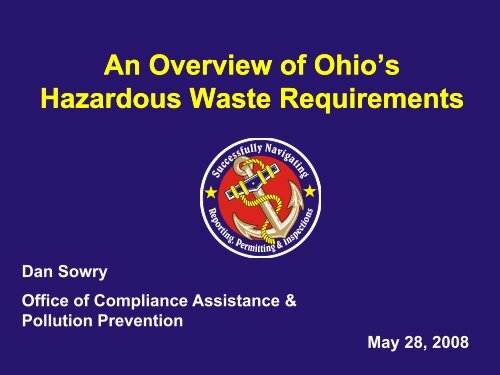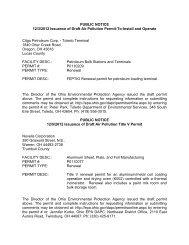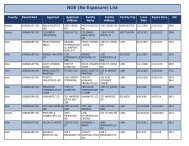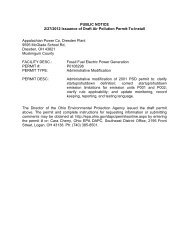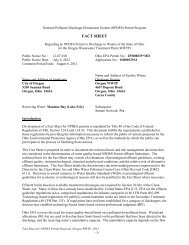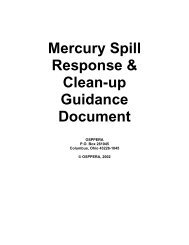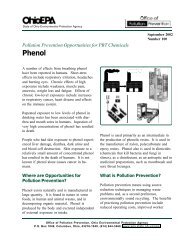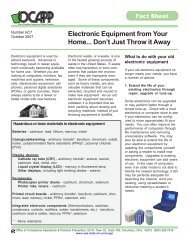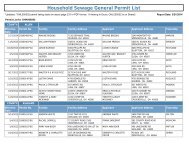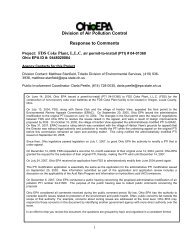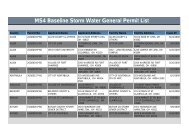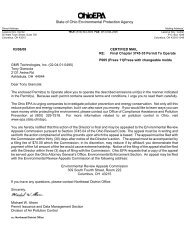An Overview of Ohio's Hazardous Waste Requirements - Ohio EPA
An Overview of Ohio's Hazardous Waste Requirements - Ohio EPA
An Overview of Ohio's Hazardous Waste Requirements - Ohio EPA
You also want an ePaper? Increase the reach of your titles
YUMPU automatically turns print PDFs into web optimized ePapers that Google loves.
<strong>An</strong> <strong>Overview</strong> <strong>of</strong> <strong>Ohio</strong>’s<br />
<strong>Hazardous</strong> <strong>Waste</strong> <strong>Requirements</strong><br />
Dan Sowry<br />
Office <strong>of</strong> Compliance Assistance &<br />
Pollution Prevention<br />
May 28, 2008
What We Will Cover<br />
<strong>Hazardous</strong> <strong>Waste</strong> Basics<br />
<strong>Waste</strong> Evaluation<br />
Generator Categories<br />
Generator <strong>Requirements</strong><br />
Universal <strong>Waste</strong> Lamp Management<br />
Most Commonly Cited Violations<br />
Resources
Resource Conservation and Recovery<br />
Act (RCRA)<br />
Cradle-To-Grave Management
<strong>Waste</strong> Evaluation
<strong>Waste</strong> Evaluation Requirement<br />
Don’t throw any<br />
waste into the<br />
dumpster unless<br />
you have<br />
confirmed and<br />
demonstrated<br />
that it is NOT a<br />
hazardous<br />
waste.
<strong>Hazardous</strong> <strong>Waste</strong> Evaluation<br />
Under <strong>Ohio</strong>’s laws, all wastes must be evaluated<br />
by the generator.<br />
Generator – any person, by site, whose act or<br />
process produces or causes a hazardous waste<br />
to become subject to the hazardous waste rules.<br />
In order for a material to be a hazardous waste, it<br />
must first be considered a waste.
What Is A <strong>Waste</strong><br />
A waste is any material that will be<br />
discarded.<br />
If you have a material that you can no<br />
longer use, it’s probably a waste.
There Are Some Exceptions…<br />
Exclusions:<br />
<strong>Ohio</strong> Administrative Code rule 3745-51-04<br />
‣ Samples<br />
Materials that t will be recycled, reused or reclaimed<br />
Only applies to certain materials<br />
Remain wastes if:<br />
‣ Placed on the land<br />
‣ Accumulated speculatively
Speculative Accumulation<br />
The<br />
hazardous<br />
waste (RCRA)<br />
program was<br />
established to<br />
prevent<br />
situations like<br />
this!
<strong>Waste</strong> Evaluation <strong>Requirements</strong><br />
Resources may include:<br />
Lab analysis<br />
Generator knowledge<br />
‣ Information from vendor/supplier<br />
‣ Material Safety Data Sheet (MSDS)<br />
‣ Process information<br />
**Need to keep information on file to<br />
show how you determined your<br />
wastes are non-hazardous.
Steps To Properly<br />
Evaluate Your <strong>Waste</strong><br />
1 st – Determine if your waste is excluded<br />
2 nd<br />
nd – Determine if your waste is listed<br />
3 rd<br />
rd – Determine if your waste exhibits a<br />
characteristic
Excluded <strong>Waste</strong>s<br />
Excluded wastes – not subject to <strong>Ohio</strong>’s<br />
hazardous waste regulations<br />
<strong>Ohio</strong> Administrative Code rule 3745-51-04<br />
Examples: Samples you send for analysis<br />
Solvent contaminated shop rags<br />
sent for cleaning and returned
Steps To Properly<br />
Evaluate Your <strong>Waste</strong><br />
2 nd – Determine if your waste is listed
Listed <strong>Hazardous</strong> <strong>Waste</strong>s<br />
Non-specific waste sources (F listed)<br />
OAC rule 3745-51-31<br />
Specific waste sources (K listed)<br />
OAC rule 3745-51-32<br />
Discarded commercial chemical products<br />
(P and U listed)<br />
OAC rule 3745-51-33
F Listed <strong>Hazardous</strong> <strong>Waste</strong>s<br />
Non-specific sources<br />
Meaning from any type <strong>of</strong> manufacturing<br />
process<br />
Examples<br />
Spent solvents / Solvent contaminated<br />
shop rags<br />
‣ F001, F002, F003, F004, F005<br />
Spent electroplating baths<br />
‣ F007, F008
F Listing Table Example<br />
Industry<br />
and <strong>EPA</strong><br />
hazardous<br />
waste no.<br />
<strong>Hazardous</strong> waste<br />
F004 The following spent non-halogenated solvents: cresols and (T)<br />
cresylic acid, and nitrobenzene; all spent solvent<br />
mixtures/blends containing, before use, a total <strong>of</strong> ten per<br />
cent or more (by volume) <strong>of</strong> one or more <strong>of</strong> the above nonhalogenated<br />
solvents or those solvents listed in F001, F002,<br />
and F005; and still bottoms from the recovery <strong>of</strong> these spent<br />
solvents and spent solvent mixtures.<br />
F005<br />
The following spent non-halogenated solvents: toluene,<br />
methyl ethyl ketone, carbon disulfide, isobutanol, pyridine,<br />
benzene, 2-ethoxyethanol, and 2-nitropropane; all spent<br />
solvent mixtures/blends containing, before use, a total <strong>of</strong> ten<br />
per cent or more (by volume) <strong>of</strong> one or more <strong>of</strong> the above<br />
non-halogenated solvents or those solvents listed in F001,<br />
F002, or F004; and still bottoms from the recovery <strong>of</strong> these<br />
spent solvents and spent solvent mixtures.<br />
Hazard<br />
code<br />
(I, T)
K Listed <strong>Hazardous</strong> <strong>Waste</strong>s<br />
Specific waste sources<br />
Meaning from a specific type <strong>of</strong> industry<br />
Examples<br />
Wood preserving - K001<br />
Iron and steel production<br />
‣ Arc furnace dust - K061<br />
‣ Spent pickle liquor - K062
K Listing Table Example<br />
Industry<br />
and <strong>EPA</strong><br />
hazardous<br />
waste no.<br />
Wood<br />
preservation<br />
K001<br />
Inorganic<br />
pigments<br />
K002………..<br />
K003………..<br />
<strong>Hazardous</strong> waste<br />
Bottom sediment sludge from the treatment <strong>of</strong><br />
wastewaters from wood preserving processes that use<br />
creosote and/or pentachlorophenol.<br />
<strong>Waste</strong>water treatment sludge from the production <strong>of</strong><br />
chrome yellow and orange pigments<br />
<strong>Waste</strong>water treatment sludge from the production <strong>of</strong><br />
molybdate orange pigments<br />
Hazard<br />
code<br />
(T)<br />
(T)<br />
(T)<br />
K004………..<br />
<strong>Waste</strong>water treatment sludge from the production <strong>of</strong><br />
zinc yellow pigments<br />
(T)
P or U Listed<br />
<strong>Hazardous</strong> <strong>Waste</strong>s<br />
Must be an unused commercial chemical product<br />
Examples <strong>of</strong> P listed hazardous wastes:<br />
Acetic acid – P058<br />
Copper cyanide – P029<br />
Examples <strong>of</strong> U listed hazardous wastes:<br />
Acetone – U002<br />
Mercury – U151
Steps To Properly<br />
Evaluate Your <strong>Waste</strong><br />
3 rd – Determine if your waste exhibits a<br />
characteristic
Characteristic<br />
<strong>Hazardous</strong> <strong>Waste</strong>s<br />
4 categories <strong>of</strong> characteristic hazardous wastes:<br />
‣ Ignitable<br />
‣ Corrosive<br />
‣ Reactive<br />
‣ Toxic
Ignitable <strong>Hazardous</strong> <strong>Waste</strong>s<br />
Flash point
Corrosive <strong>Hazardous</strong> <strong>Waste</strong>s<br />
pH < 2 or pH > 12.5<br />
Usually a liquid<br />
D002 hazardous waste code<br />
Examples include:<br />
‣ <strong>Waste</strong> acids<br />
‣ Alkaline cleaning fluids<br />
‣ <strong>Waste</strong> battery acids
Reactive <strong>Hazardous</strong> <strong>Waste</strong>s<br />
Explosive, unstable, reacts violently with water<br />
D003 hazardous waste code<br />
Examples include:<br />
‣ <strong>Waste</strong> bleaches<br />
‣ Other oxidizers
Toxic <strong>Hazardous</strong> <strong>Waste</strong>s<br />
Contain toxic constituents above regulatory levels<br />
Heavy metals, insecticides, herbicides and other<br />
organics<br />
Determined by Toxicity it Characteristic ti Leaching<br />
Procedure (TCLP)<br />
D004 through D043 hazardous waste codes<br />
Examples include:<br />
‣ Electronic equipment containing lead<br />
‣ Spent foundry sand<br />
‣ Air emission control dust
Toxic <strong>Hazardous</strong> <strong>Waste</strong><br />
Examples<br />
<strong>Ohio</strong> <strong>EPA</strong><br />
<strong>Hazardous</strong><br />
<strong>Waste</strong> No.<br />
Contaminant CAS No. Regulatory<br />
Level (mg/l)<br />
D004 Arsenic 7440-38-2 50 5.0<br />
D005 Barium 7440-39-3 100.0<br />
D006 Cadmium 7440-43-9 43 10 1.0<br />
D007 Chromium 7440-47-3 5.0<br />
D008 Lead 7439-92-1 92 50 5.0<br />
D009 Mercury 7439-97-6 0.2<br />
D010 Selenium 7782-49-2 2 1.0<br />
D011 Silver 7440-22-4 5.0
Do I Have A <strong>Hazardous</strong> <strong>Waste</strong><br />
Has your business generated a waste<br />
Yes<br />
Is it excluded<br />
No<br />
Isthewasteon<strong>Ohio</strong><strong>EPA</strong>’s<br />
s<br />
F, K, P or U lists<br />
Yes<br />
Yes<br />
You do not have a hazardous waste.<br />
You have a listed hazardous<br />
waste<br />
No<br />
Does the waste have any<br />
hazardous waste characteristics<br />
No<br />
Yes<br />
Does the waste have any<br />
hazardous waste characteristics<br />
Yes<br />
You have a listed and<br />
characteristic hazardous waste<br />
Not a hazardous<br />
waste<br />
You have a characteristic<br />
hazardous waste
Generator Categories
Generator Categories<br />
<strong>Ohio</strong> has three hazardous ardo waste generator<br />
categories:<br />
Conditionally Exempt Small Quantity Generators<br />
(CESQGs<br />
CESQGs);<br />
Small Quantity Generators (SQGs); and<br />
Large Quantity Generators (LQGs).
Determining Your Category<br />
Total weight <strong>of</strong> hazardous waste that you generate<br />
(produce) in any given month <strong>of</strong> the calendar year;<br />
For example: <strong>Hazardous</strong> waste that you generate<br />
between October 1 st and October 31 st<br />
AND<br />
Total amount <strong>of</strong> hazardous waste on-site at any given<br />
time (only pertains to CESQGs and SQGs)<br />
NOTE: Generator categories are NOT determined by the<br />
weight <strong>of</strong> waste shipped <strong>of</strong>f-site<br />
site.
Conditionally Exempt Small<br />
Quantity Generators (CESQGs)<br />
You are a CESQG if you:<br />
generate no more than 220 pounds <strong>of</strong> hazardous<br />
waste per month; AND<br />
never accumulate more than 2,200 pounds <strong>of</strong><br />
hazardous waste on your property<br />
Note: 220 pounds is about half <strong>of</strong> a 55-gallon drum<br />
2,200 200 pounds is about five 55-gallon drums
What If I Go Over The<br />
CESQG Limits<br />
Generate more than 220 pounds <strong>of</strong> HW/month<br />
you become either an SQG or an LQG for that<br />
month<br />
Accumulate more than 2,200 pounds <strong>of</strong> HW at<br />
any given time<br />
you become an LQG until that HW<br />
is moved <strong>of</strong>f-site
Small Quantity Generators<br />
(SQGs)<br />
You are an SQG if you:<br />
generate more than 220 pounds but less than<br />
2,200 pounds <strong>of</strong> hazardous waste/month; and<br />
never accumulate over 13,200 pounds <strong>of</strong><br />
hazardous waste on-site.
What If I Go Over The<br />
SQG Limits<br />
Generate more than 2,200 pounds <strong>of</strong> hazardous<br />
waste in a calendar month<br />
you become an LQG until that hazardous waste is<br />
moved <strong>of</strong>f-site<br />
Accumulate over 13,200 pounds <strong>of</strong> hazardous<br />
waste on-site<br />
you become a treatment, storage and disposal facility<br />
(TSDF) and must have a hazardous waste installation<br />
and operation permit
Large Quantity Generators<br />
(LQGs)<br />
You are an LQG if you:<br />
generate 2,200 or more pounds <strong>of</strong> hazardous<br />
waste/month<br />
Note: LQGs do not have a limit on volume <strong>of</strong><br />
hazardous waste stored on-site
What If I Change<br />
Generator Categories<br />
Termed episodic generation<br />
Must manage your hazardous waste under all<br />
applicable generator requirements for hazardous<br />
wastes generated that month for as long as that<br />
waste remains on-site<br />
If you reach LQG status at any time during the<br />
calendar year, you must file an annual report
Generator <strong>Requirements</strong>
Determining Your Generator<br />
<strong>Requirements</strong><br />
CESQGs follow OAC rule 3745-51-05<br />
SQGs and LQGs follow OAC<br />
Chapter 3745-5252
Generator <strong>Requirements</strong><br />
Summary Table<br />
Management requirements<br />
OAC references<br />
CESQG, SQG, or LQG compliance requirement
<strong>Hazardous</strong> <strong>Waste</strong><br />
Determination<br />
Determine if your waste is hazardous waste<br />
OAC rule 3745-52-11<br />
Failure to properly evaluate your waste may lead<br />
to unsafe conditions or violations from improper<br />
management
Remember This!<br />
Don’t throw any<br />
waste into the<br />
dumpster unless<br />
you have<br />
confirmed and<br />
demonstrated<br />
that it is NOT a<br />
hazardous<br />
waste.
U.S. <strong>EPA</strong> Identification<br />
Number<br />
Only required for SQGs and LQGs<br />
CESQGs are not required to obtain U.S. <strong>EPA</strong> ID<br />
numbers<br />
U.S. <strong>EPA</strong> ID numbers are site specific
How Do I Obtain A U.S. <strong>EPA</strong><br />
Identification Number<br />
Print a copy <strong>of</strong> <strong>EPA</strong> Form 9029 from DHWM’s Web site<br />
or call (614) 644-2977 and ask for a copy <strong>of</strong> the<br />
Notification <strong>of</strong> Regulated <strong>Waste</strong> Activity booklet<br />
Complete the form in its entirety using the<br />
instructions provided<br />
Mail the completed and signed original <strong>EPA</strong> form 9029<br />
to:<br />
<strong>Ohio</strong> <strong>EPA</strong> – DHWM<br />
Regulatory and Information Services<br />
P.O. Box 1049<br />
Columbus, <strong>Ohio</strong> 43216-1049
How Long May I<br />
Accumulate (store) HW On-site<br />
CESQGs do not have any storage time limits<br />
SQGs can store hazardous waste on-site for up<br />
to 180 days; HOWEVER, if transporting a<br />
distance <strong>of</strong> 200 miles or more, can store for up<br />
to 270 days (30 day extension available)<br />
LQGs can store hazardous waste on-site<br />
for up to 90 days (30 day extension available)
What is Treatment<br />
Defined in <strong>Ohio</strong> Administrative Code rule<br />
3745-50-10(A)(125)<br />
Treatment: any method, technique or process,<br />
designed to render waste non-hazardous, less-<br />
hazardous; safer to transport, store or dispose <strong>of</strong>;<br />
or amenable for recovery, amendable for<br />
storage or reduced in volume.
May I Treat My<br />
<strong>Hazardous</strong> <strong>Waste</strong> On-site<br />
Some forms <strong>of</strong> treatment by generators are<br />
allowed without a hazardous waste permit:<br />
Neutralization<br />
ti<br />
Polymerization<br />
Stabilization<br />
ti<br />
<strong>Waste</strong>water treatment<br />
See “Generator Treatment” guidance document<br />
Consult with us if you wish to treat your hazardous<br />
waste
What Is<br />
Satellite Accumulation<br />
Satellite accumulation – term for the temporary<br />
storage <strong>of</strong> hazardous waste near where it is<br />
generated<br />
Found in <strong>Ohio</strong> Administrative Code (OAC) rule<br />
3745-52-34(C)<br />
Only applies to SQGs and LQGs<br />
Use <strong>of</strong> this rule reduces some regulatory<br />
requirements for storage areas
What <strong>Requirements</strong> Apply to<br />
Satellite Accumulation Areas<br />
Up to 55 gallons <strong>of</strong> HW in containers at or near<br />
each point <strong>of</strong> generation<br />
Containers must be under control <strong>of</strong> the operator<br />
<strong>of</strong> the process which generated the waste<br />
C t i t b tibl ith t d i<br />
Containers must be compatible with waste and in<br />
good condition – not leaking
What <strong>Requirements</strong> Apply to<br />
Satellite Accumulation Areas<br />
Containers must be marked with the words<br />
“<strong>Hazardous</strong> <strong>Waste</strong>” (or other words that identify<br />
contents)<br />
Containers must remain closed except<br />
when adding or removing hazardous waste
What Happens When I<br />
Reach The 55-Gallon Limit<br />
Place the date on the container when it happened<br />
Move the container to your centralized storage<br />
area (i.e., 90 or 180/270 day area) within three<br />
days <strong>of</strong> the date that you place on the container<br />
Begin complying with the SQG or LQG<br />
hazardous waste accumulation<br />
requirements
What Are The Container<br />
Management <strong>Requirements</strong><br />
Found in <strong>Ohio</strong> Administrative Code (OAC) rules<br />
3745-66-70<br />
through 3745-66<br />
66-77<br />
They only apply ppy to SQGs and LQGs<br />
though not required, these preventative measures<br />
g q , p<br />
are good for CESQGs to follow
What Are The Container<br />
Management <strong>Requirements</strong> For<br />
SQGs and LQGs<br />
Must be in good condition<br />
Compatible with the hazardous waste and area<br />
Clearly labeled as “<strong>Hazardous</strong> <strong>Waste</strong>”<br />
Closed (lids)<br />
Conduct weekly inspections
What Are The Container<br />
Management <strong>Requirements</strong> For<br />
SQGs and LQGs<br />
Label storage start date<br />
Maintain aisle space<br />
Ignitable/reactive located 15 meters from<br />
facility’s property line<br />
U.S. <strong>EPA</strong> air emission standards (LQGs only)
What Are The Tank Management<br />
<strong>Requirements</strong><br />
They only apply to SQGs and LQGs<br />
though not required, these preventative measures<br />
are good for CESQGs to follow<br />
Found in <strong>Ohio</strong> Administrative Code (OAC) rules<br />
3745-66<br />
66-90<br />
through h 3745-66<br />
66-101
What Are The SQG Tank<br />
Management <strong>Requirements</strong><br />
Good condition<br />
Compatible with waste and area<br />
Labeled as “<strong>Hazardous</strong> <strong>Waste</strong>”<br />
Accumulation start date<br />
Daily inspections
What Are The LQG Tank<br />
Management <strong>Requirements</strong><br />
Good condition<br />
Compatible with waste and area<br />
Labeled as “<strong>Hazardous</strong> <strong>Waste</strong>”<br />
Accumulation start date<br />
Daily inspections<br />
U.S. <strong>EPA</strong> air emission standards apply<br />
Secondary containment
What Am I Required To Do Before<br />
I Ship My HW Off-site<br />
Termed “Pretransport” – Found in OAC rules 3745-52-30<br />
to 3745-52-32<br />
CESQGs are not required to prepare a manifest<br />
SQGs and LQGs must prepare manifest and<br />
Package your HW<br />
Label each package <strong>of</strong> HW<br />
Mark each package <strong>of</strong> HW<br />
Placard or <strong>of</strong>fer the initial transporter the appropriate<br />
placards<br />
Contact t Public Utilities Commission i <strong>of</strong> <strong>Ohio</strong> for more<br />
information
Does My Business Need<br />
Personnel Training<br />
i <strong>Ohio</strong> Administrative Code rule 3745-65-16<br />
CESQGs are not required to conduct personnel<br />
training<br />
i<br />
SQGs must ensure that all employees are<br />
thoroughly familiar with proper waste handling<br />
and emergency procedures<br />
LQGs must conduct classroom instruction or<br />
on-the-job personnel training for facility<br />
employees and maintain documentation<br />
<strong>of</strong> personnel training
How Do I Prepare For<br />
Emergencies<br />
Found in OAC rules 3745-65<br />
65-30<br />
to 3745-65<br />
65-37<br />
No requirements for CESQGs<br />
SQGs and LQGs must:<br />
Maintain emergency equipment on-site<br />
Maintain and operate your facility to minimize the<br />
possibility <strong>of</strong> emergencies<br />
Test and maintain i your emergency equipment and<br />
record the inspections in a log<br />
Maintain adequate aisle space<br />
Make arrangements with local emergency authorities
When Do I Need Emergency<br />
Procedures & A Contingency Plan<br />
SQGs –at tl least one employee on-site or on-call to<br />
respond to all emergencies<br />
LQGs – prepare and maintain a<br />
written contingency plan<br />
Maintain all reports <strong>of</strong> contingency plan<br />
implementation on-file and report the incidents to<br />
<strong>Ohio</strong> <strong>EPA</strong><br />
A copy <strong>of</strong> your contingency plan must be<br />
maintained at your facility & submitted to local<br />
police, fire, hospitals, emergency response teams<br />
and <strong>Ohio</strong> <strong>EPA</strong>
What Are My Recordkeeping<br />
<strong>Requirements</strong><br />
Found in OAC rule 3745-52<br />
52-40<br />
CESQGs, SQGs and LQGs must keep a copy <strong>of</strong><br />
the following for at least 3 years:<br />
Test results;<br />
<strong>Waste</strong> evaluation; and/or<br />
<strong>Waste</strong> determinations
What Are SQG’s Additional<br />
Recordkeeping <strong>Requirements</strong><br />
Additionally, SQGs must tk keep a copy <strong>of</strong> fth these for at<br />
least 3 years:<br />
Weekly container inspections;<br />
All manifests; and<br />
Land disposal restriction notifications,<br />
certifications and waste analysis data
What Are LQG’s Additional<br />
Recordkeeping <strong>Requirements</strong><br />
LQGs must keep a copy <strong>of</strong> these for at least 3 years:<br />
Everything mentioned in the previous two slides;<br />
Personnel training documents;<br />
<strong>An</strong>nual reports; and<br />
Daily tank inspection logs
What Are My Manifesting<br />
<strong>Requirements</strong><br />
Manifests are HW tracking documents<br />
Found in OAC rules 3745-52-2020 to 3745-52-2323<br />
Only SQGs and LQGs must manifest their HW<br />
Each person who transports, stores, treats or<br />
disposes must sign & retain a copy<br />
Must receive signed copy <strong>of</strong> your manifest from<br />
the final destination facility<br />
Each transporter must have a copy for their<br />
records<br />
Destination facility must have a copy
What Is <strong>An</strong> Exception Report<br />
Found in OAC rule 3745-52<br />
52-42<br />
Exception reports are part <strong>of</strong> the RCRA manifest<br />
tracking system<br />
After you send waste <strong>of</strong>f-site for disposal, the<br />
TSDF is required to return to you a copy <strong>of</strong><br />
the original manifest<br />
If you don't receive the manifest from the TSDF,<br />
then you must submit an exception report to <strong>Ohio</strong><br />
<strong>EPA</strong>
Am I Required To File <strong>An</strong><br />
Exception Report<br />
CESQGs - Not Required<br />
SQGs – Required<br />
If you do not receive a copy <strong>of</strong> the manifest signed<br />
by the designated facility within 60 days: Send<br />
exception report to <strong>Ohio</strong> <strong>EPA</strong><br />
LQGs – Required<br />
If you do not receive a copy <strong>of</strong> the signed manifest<br />
within 35 days: Contact transporter and/or the<br />
designated facility<br />
If you do not receive a copy <strong>of</strong> the signed manifest<br />
within 45 days: Send exception report to <strong>Ohio</strong> <strong>EPA</strong>
What Are The Land Disposal<br />
Restrictions (LDRs)<br />
Found in OAC Chapter 3745-270<br />
These only apply to SQGs and LQGs<br />
Standards developed to ensure that toxic<br />
constituents present in hazardous waste are<br />
properly treated before land disposal<br />
Under LDRs, generators need to complete a<br />
notification (one-time) which accompanies manifest<br />
to TSD facility<br />
TSDFs treat your HW to meet LDRs
Do I File an <strong>An</strong>nual Report<br />
<strong>Ohio</strong> Administrative Code rule 3745-52-41<br />
Only LQGs file annual reports<br />
Report provides <strong>Ohio</strong> <strong>EPA</strong> and U.S. <strong>EPA</strong> with data<br />
concerning your facility’s hazardous waste<br />
generation, management and waste minimization<br />
activities<br />
Due by March 1 st
Lamp Management
What We Will Cover<br />
Background information<br />
UW handler categories<br />
Green-tipped lamps<br />
Crushing<br />
Packaging/Labeling<br />
Storage<br />
Notification<br />
Manifesting<br />
Transportation<br />
Recordkeeping
Background<br />
What are the UW rules<br />
What is a lamp
Who are UW handlers<br />
UW handlers are persons who<br />
Generate<br />
Receive and<br />
Store (but do not treat, dispose <strong>of</strong> or recycle UW<br />
generated elsewhere)<br />
UW handlers cannot treat, dispose <strong>of</strong> or recycle<br />
UW<br />
UW Destination Facilities – must have a permit
What are the UW handler<br />
categories<br />
Two categories:<br />
Small quantity handlers<br />
‣Accumulates onsite less than 5,000 kilograms<br />
(11,023 pounds) <strong>of</strong> UW (not by type) at any time.<br />
Large quantity handlers<br />
‣Accumulates onsite more than 5,000 kilograms<br />
(11,023 pounds) <strong>of</strong> UW (not by type) at any time.<br />
** do not confuse these categories with the<br />
hazardous waste generator categories<br />
(CESQGs, SQGs and LQGs)
What about those<br />
green-tipped lamps<br />
They still contain mercury – though not above<br />
regulatory levels (.2 mg/L)<br />
We encourage recycling rather than disposal<br />
If disposed, must evaluate and retain<br />
documentation for three years
Can I use a lamp crusher<br />
to crush my lamps<br />
UWR prohibits handlers<br />
from crushing lamps<br />
If you crush your lamps,<br />
you must manage them<br />
under the hazardous waste<br />
requirements
What are the packaging<br />
requirements for UW lamps<br />
Must be designed to<br />
contain potential<br />
releases<br />
Accidentally broken<br />
or damaged lamps<br />
can be managed as<br />
UW<br />
Warning about<br />
mercury…
What are the labeling<br />
requirements for UW lamps<br />
Must be clearly marked<br />
“Universal <strong>Waste</strong> Lamps”;<br />
“<strong>Waste</strong> Lamps”; or<br />
“Used Lamps”<br />
Be able to demonstrate<br />
accumulation time
How long can I accumulate my<br />
UW lamps<br />
Up to one year on-site<br />
regardless <strong>of</strong> your handler<br />
category<br />
If greater than one year is<br />
required, you must be<br />
able to prove why it is<br />
necessary
Am I required to notify <strong>Ohio</strong> <strong>EPA</strong><br />
<strong>of</strong> my UW activities<br />
Small quantity handlers are NOT required to notify<br />
<strong>Ohio</strong> <strong>EPA</strong> or to obtain a U.S. <strong>EPA</strong> identification<br />
number<br />
Large quantity handlers are required to notify and<br />
obtain a U.S. <strong>EPA</strong> identification number<br />
(unless you already have one)
Must I manifest my UW lamps<br />
NO<br />
UW handlers are not required to manifest their<br />
<strong>of</strong>f-site shipments <strong>of</strong> UW<br />
UW handlers, however, must ensure delivery to<br />
another UW handler or to a permitted<br />
destination facility
YES<br />
Can I transport my own<br />
UW lamps<br />
- deliver only to another UW handler, a UW<br />
transfer facility or to a permitted UW<br />
destination facility<br />
- must follow all DOT requirements<br />
- responsible for spills and clean up
No<br />
Can I take or send my lamps<br />
to any lamp recycler<br />
UW handlers must<br />
ensure delivery to<br />
another UW handler<br />
or to a permitted<br />
destination facility
What are my recordkeeping<br />
requirements<br />
No recordkeeping requirements for small quantity<br />
handlers <strong>of</strong> UW<br />
Large quantity handlers <strong>of</strong> UW must retain on-<br />
and <strong>of</strong>f-site shipment records for at least three<br />
years<br />
Name and address<br />
Quantity <strong>of</strong> each type <strong>of</strong> UW<br />
Date <strong>of</strong> shipment
Most Commonly<br />
Cited Violations
Most Commonly Cited Violations<br />
Failure to evaluate your waste<br />
Not filing your annual report correctly<br />
Not properly managing containers or maintaining<br />
an inspection log<br />
Not testing or maintaining emergency equipment<br />
Not labeling used oil containers, tanks or fill pipes
Key Point With<br />
<strong>Waste</strong> Evaluation<br />
Don’t throw any<br />
waste into the<br />
dumpster unless<br />
you have<br />
confirmed and<br />
demonstrated<br />
that it is NOT a<br />
hazardous<br />
waste.
Avoiding <strong>An</strong>nual<br />
Reporting Violations<br />
<strong>Ohio</strong> Administrative i ti Code rule 3745-52<br />
52-41<br />
DuebyMarch1 st<br />
Only report hazardous waste; not universal waste or<br />
used oil<br />
Check accuracy and completeness<br />
Questions Contact Tammy Heffelfinger at<br />
614-644-2954
Container Management<br />
<strong>Ohio</strong> Administrative Code rules<br />
3745-66-73 and 3745-66-74<br />
Keep containers closed while in storage<br />
Do not open, handle or store containers in a manner<br />
that will cause them to rupture or leak<br />
Conduct inspections <strong>of</strong> container storage areas, at<br />
least weekly, looking for signs <strong>of</strong> leaks or<br />
deterioration<br />
Record inspections in a log or summary
Emergency Equipment<br />
<strong>Ohio</strong> Administrative Code rule 3745-65<br />
65-33<br />
Alarm systems, fire protection equipment, spill<br />
control equipment and decontamination<br />
equipment must be tested and maintained as<br />
necessary to ensure proper operation in time <strong>of</strong><br />
emergency<br />
Record inspections in log or<br />
summary
Avoiding Used Oil Violations<br />
<strong>Ohio</strong> Administrative Code Chapter 3745-279<br />
Labeling – “Used Oil”<br />
Do Not Label as “<strong>Waste</strong> Oil” or “<strong>Hazardous</strong> <strong>Waste</strong>”<br />
Storage – Tanks or Containers<br />
Releases
Resources
E-Mail Updates<br />
Permitting<br />
Enforcement<br />
Rules<br />
General/Guidance<br />
<strong>An</strong>nual Reports<br />
The Notifier<br />
Cessation <strong>of</strong> Regulated Operations (CRO)<br />
News<br />
www.epa.state.oh.us/ocapp/emailform.html<br />
t / ht l
<strong>An</strong>swer Place<br />
Search for answers to your questions<br />
Ask a question via e-mail<br />
Automatically provides answers based on<br />
information in database<br />
http://ohioepa.custhelp.com<br />
oepa e p co
Forms, Lists and Checklists<br />
Updated and current versions<br />
Includes<br />
Notification form (<strong>EPA</strong> 9029)<br />
<strong>An</strong>nual Report Forms<br />
Permit Application Forms<br />
Permit Modification/Renewal Checklists<br />
Compliance Checklists<br />
Universal <strong>Waste</strong> and Used Oil Forms<br />
CRO Forms<br />
www.epa.state.oh.us/dhwm/formslistchklist.html
Publications, Guidance<br />
Documents, Fact Sheets<br />
Organized alphabetically ll by topic<br />
Each topic section <strong>of</strong>fers information in different formats<br />
including:<br />
U.S. <strong>EPA</strong> web based information<br />
Guidance Documents<br />
Notifier Articles<br />
Fact Sheets<br />
Recyclers Lists<br />
Forms and Checklists<br />
www.epa.state.oh.us/dhwm/guideancedocs.html
Guidance Documents<br />
Intended to cover information that pertains to a large<br />
group <strong>of</strong> people<br />
Listed alphabetically<br />
Most current and updated versions<br />
www.epa.state.oh.us/dhwm/guidancedocuments.html<br />
t / d t ht
Search Written Regulatory<br />
Interpretations<br />
Written regulatory responses to questions<br />
received<br />
Click on months for most recent<br />
correspondence<br />
www.epa.state.oh.us/dhwm/search.html
Recyclers Lists<br />
DHWM’s Recyclers Lists available here:<br />
www.epa.state.oh.us/dhwm/guideancedocs.html#<br />
recycleList<br />
Also available from OCAPP<br />
<strong>Ohio</strong> <strong>EPA</strong>’s Office <strong>of</strong> Compliance Assistance and<br />
Pollution Prevention<br />
www.epa.state.oh.us/ocapp/p2/wastex.html<br />
html
The Notifier<br />
DHWM’s quarterly newsletter<br />
Available on the Web<br />
Use the list-serve serve to get updates<br />
www.epa.state.oh.us/dhwm/newsletter.html
<strong>Ohio</strong>’s <strong>Hazardous</strong> <strong>Waste</strong> Rules<br />
Available on our Web page<br />
Most current and updated d versions<br />
Can access the <strong>Ohio</strong> Revised Code as well<br />
as the <strong>Ohio</strong> Administrative Code<br />
www.epa.state.oh.us/dhwm/laws_regs.html
<strong>Ohio</strong> <strong>EPA</strong> Resources<br />
Office <strong>of</strong> Compliance Assistance & Pollution<br />
Prevention<br />
Available weekdays from 8-5<br />
Call (800) 329-7518<br />
mail: dan.sowry@epa.state.oh.us<br />
E-mail:<br />
DHWM’s Regulatory Services Unit<br />
Available weekdays from 8-5<br />
Call (614) 644-2917<br />
E-mail:<br />
jeff.mayhugh@epa.state.oh.us


